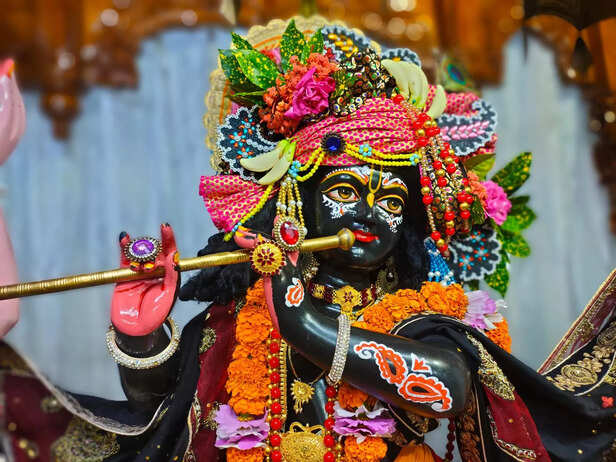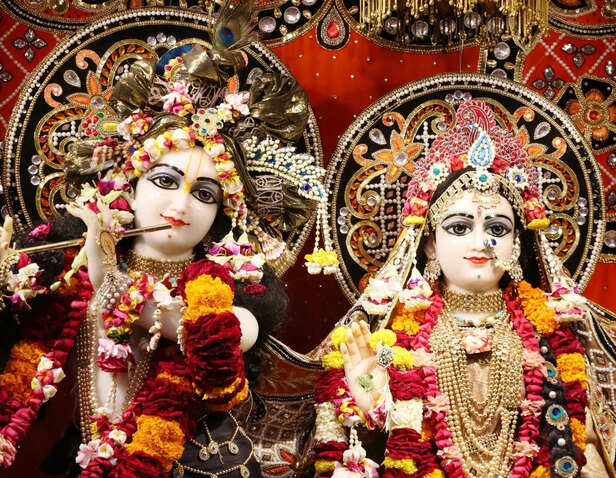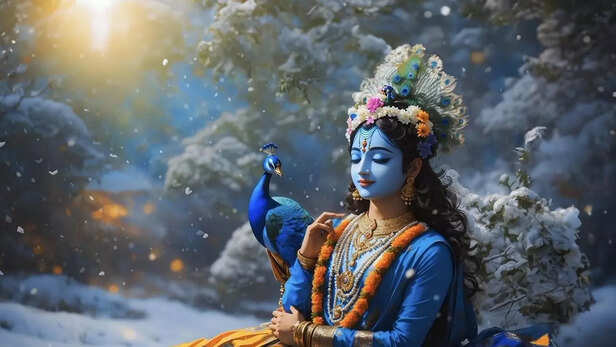Why Rohini Nakshatra Was Chosen for Krishna’s Janmashtami
Riya Kumari | Aug 16, 2025, 02:04 IST
( Image credit : Pixabay )
In choosing Rohini, Krishna chose the language of beauty, fertility, harmony, and divine care. And every Janmashtami night, when the Moon graces Rohini again, the same cosmic fragrance fills the air, as if the universe is reminding us: the Divine still descends, if only we are ready to receive Him.
In Sanatana Dharma, time is not merely a sequence of hours and days, it is a living force. Each moment is infused with its own guna (quality), a pulse in the eternal rhythm of the cosmos. The ancient rishis taught that the alignment of stars, planets, and lunar mansions (Nakshatras) is not a coincidence, but the very language through which the Divine arranges its leelas (cosmic plays). When Bhagavan Krishna chose to descend upon earth, this choice was not random. Every detail, the year, the month, the tithi, the planetary positions, and most importantly, the Rohini Nakshatra, was selected with precision, as though the universe itself was laying out a royal carpet for the Supreme.

Rohini is the fourth of the 27 Nakshatras, ruled by the Moon (Chandra), and is symbolized by a chariot or a celestial cart. In the Vedic Jyotish, Rohini is considered the most beloved star of the Moon, so dear that Chandra spends the longest time here in his monthly cycle. The Brihat Samhita describes Rohini as fertile, graceful, and creative, a Nakshatra of beauty, nourishment, and life-giving abundance. It is the star under which seeds sprout, flowers bloom, and life takes form. The Shastras associate it with Shakti, the feminine creative energy that nurtures and sustains the world.
In the Srimad Bhagavatam (10.3.1–10.5), when Krishna appeared, it was described as a night full of auspicious omens, gentle winds, blooming lotuses, and rivers flowing with crystal clarity. Rohini’s very nature matched this mood: the time when creation is at its most generous and the earth is most ready to receive a divine seed.

In Vedic thought, the Moon (Chandra) is the karaka (significator) of the mind, emotions, and nourishment. Rohini, being its favorite abode, represents the perfect balance between softness and strength. For the birth of Krishna, who came not as a distant God but as a child to be loved, held, and nurtured, the Moon’s most tender and auspicious position was chosen.
The motherly embrace of Rohini symbolized the warmth the world would feel upon His arrival. Just as Rohini’s celestial energy draws out the best from nature, so would Krishna draw out the hidden sweetness from human hearts.

Rohini lies in Vrishabha Rashi (Taurus), ruled by Shukra (Venus), the planet of beauty, harmony, and prosperity. The Shukra Tatva represents preservation, comfort, and the fullness of life, qualities that align with Krishna’s mission as the protector of Dharma.
The Vishnu Purana says that Vishnu takes avataras “whenever Dharma declines.” Rohini’s placement in Taurus ensured that the Avatar would not only destroy adharma, but also preserve and beautify life for those who followed the path of righteousness.

On that midnight, the Moon in Rohini was in perfect harmony with the other planets, a rare alignment that signaled balance between the material and spiritual realms. The Jyotisha Shastras say that such alignments are yuga-sandhi moments, thresholds between ages, where a divine intervention can alter the course of history.
The choice of Rohini was a declaration that Krishna’s birth was not only an earthly event but a cosmic turning point.
If we look deeply, the Rohini moment teaches us something beyond astrology: it tells us that right action requires right timing. Even the Lord waited for the perfect star to rise before stepping into His leela. In our own lives, this is a reminder that patience is not passivity. Just as farmers sow seeds when the soil is most ready, and poets choose words when the heart is ripe, so too must we align our actions with the inner and outer rhythms of Dharma.
Rohini Nakshatra whispers this truth, that the universe has its seasons, and when the moment is right, even the impossible becomes inevitable.
The Nature of Rohini

Lord krishna
( Image credit : Pexels )
Rohini is the fourth of the 27 Nakshatras, ruled by the Moon (Chandra), and is symbolized by a chariot or a celestial cart. In the Vedic Jyotish, Rohini is considered the most beloved star of the Moon, so dear that Chandra spends the longest time here in his monthly cycle. The Brihat Samhita describes Rohini as fertile, graceful, and creative, a Nakshatra of beauty, nourishment, and life-giving abundance. It is the star under which seeds sprout, flowers bloom, and life takes form. The Shastras associate it with Shakti, the feminine creative energy that nurtures and sustains the world.
In the Srimad Bhagavatam (10.3.1–10.5), when Krishna appeared, it was described as a night full of auspicious omens, gentle winds, blooming lotuses, and rivers flowing with crystal clarity. Rohini’s very nature matched this mood: the time when creation is at its most generous and the earth is most ready to receive a divine seed.
The Moon, Motherhood, and the Divine Child

Shri krishna
( Image credit : Pexels )
In Vedic thought, the Moon (Chandra) is the karaka (significator) of the mind, emotions, and nourishment. Rohini, being its favorite abode, represents the perfect balance between softness and strength. For the birth of Krishna, who came not as a distant God but as a child to be loved, held, and nurtured, the Moon’s most tender and auspicious position was chosen.
The motherly embrace of Rohini symbolized the warmth the world would feel upon His arrival. Just as Rohini’s celestial energy draws out the best from nature, so would Krishna draw out the hidden sweetness from human hearts.
The Star of Preservation

Krishna
( Image credit : Pixabay )
Rohini lies in Vrishabha Rashi (Taurus), ruled by Shukra (Venus), the planet of beauty, harmony, and prosperity. The Shukra Tatva represents preservation, comfort, and the fullness of life, qualities that align with Krishna’s mission as the protector of Dharma.
The Vishnu Purana says that Vishnu takes avataras “whenever Dharma declines.” Rohini’s placement in Taurus ensured that the Avatar would not only destroy adharma, but also preserve and beautify life for those who followed the path of righteousness.
Cosmic Harmony on Janmashtami Night

Universe
( Image credit : Pexels )
On that midnight, the Moon in Rohini was in perfect harmony with the other planets, a rare alignment that signaled balance between the material and spiritual realms. The Jyotisha Shastras say that such alignments are yuga-sandhi moments, thresholds between ages, where a divine intervention can alter the course of history.
The choice of Rohini was a declaration that Krishna’s birth was not only an earthly event but a cosmic turning point.
A Lesson for Us
Rohini Nakshatra whispers this truth, that the universe has its seasons, and when the moment is right, even the impossible becomes inevitable.
